
<< Back | Home | Site Map
"Freight" is the modern term used for consignments, however the term "goods" was the usual term used to describe non-passenger traffic. This section will cover the regularly scheduled trains; goods trains that also conveyed passengers were referred to as "mixed" trains and are covered in the Passenger Traffic section.
Mr. C. Bildstien, Member for Mildura, claimed on 26-7-1990 that State government moves to force oil companies to use V/Line for the transportation of petrol to country areas could force up the price of petrol. Petrol was being delivered at present by rail to Barry Beach (Esso), Horsham, Mildura, Shepparton, Swan Hill and Wodonga. Mr. Bildstien was concerned that the government would not renew road transport permits to those companies that did comply with its plans to increase the amount of petrol being delivered by rail from 330,000 tonnes to 625,000 tonnes.
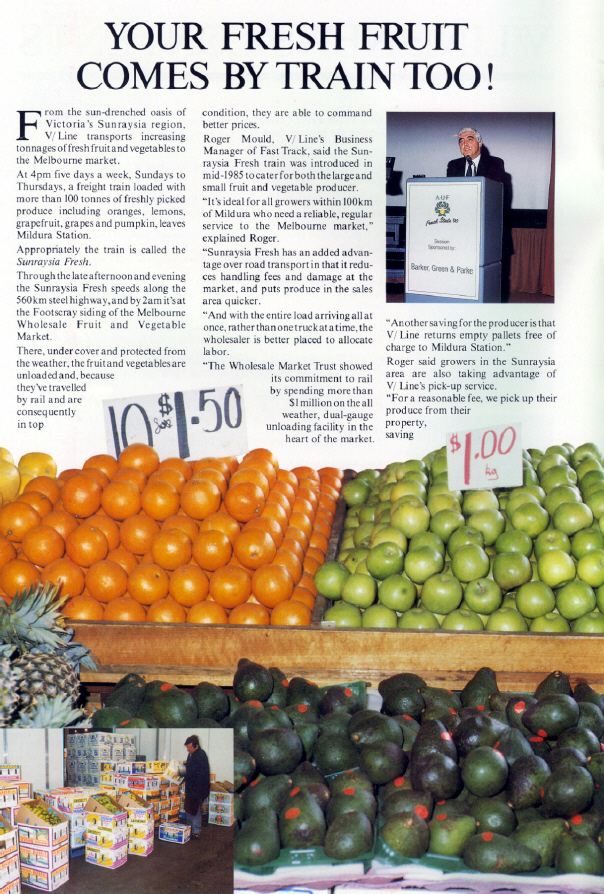
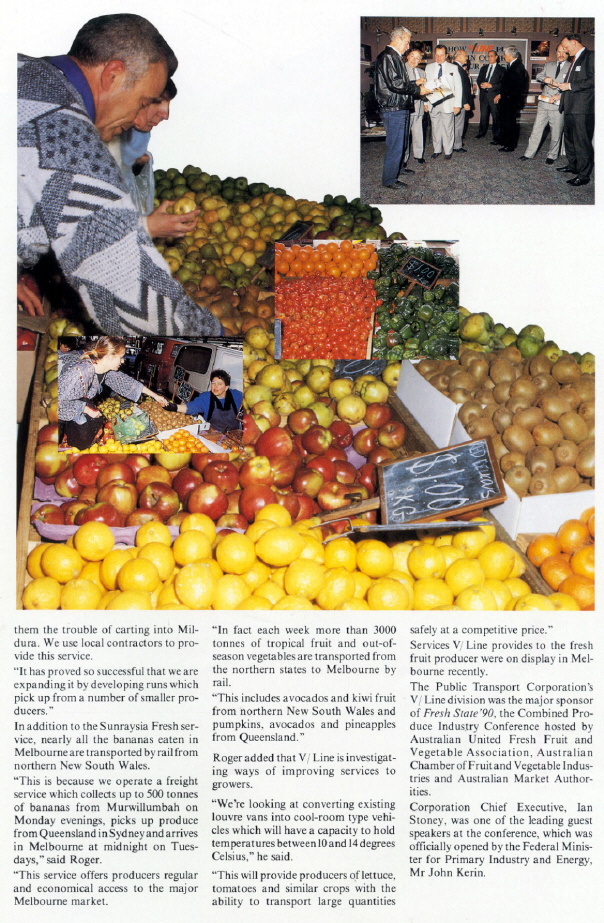
Article from V/Line News October/November 1990 on the "Sunraysia Fresh" express overnight goods service from Mildura to Melbourne. Source: Bruce McLean Collection
In January 1991, V/Line introduced a Power Pack service for refrigerated containers. Power from a generator is transferred to each container wagon and power outlets enable each container to be plugged into the power supply.
The first shipment of refrigerated containers consisted of 29 containers of oranges from packing sheds in Renmark (South Australia) and Mildura, loaded through Wakefield's transport at Merbein. The "mobile cool room" client was Australian Reefer Leasing and the oranges were destined for Malaysia, exported through the Port of Melbourne.
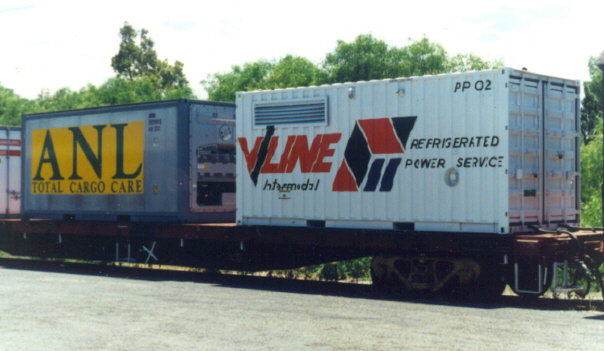
In January 1991, V/Line placed into service their first power pack to provide on-board power for refrigerated containers. Built into a container itself, the power pack fed the electrical supply through cables that were specially fitted to wagons to provide a continuous inter-connected power system. Power pack PP02 was the first to appear in Mildura on 15-1-1991. Photo: Bruce McLean
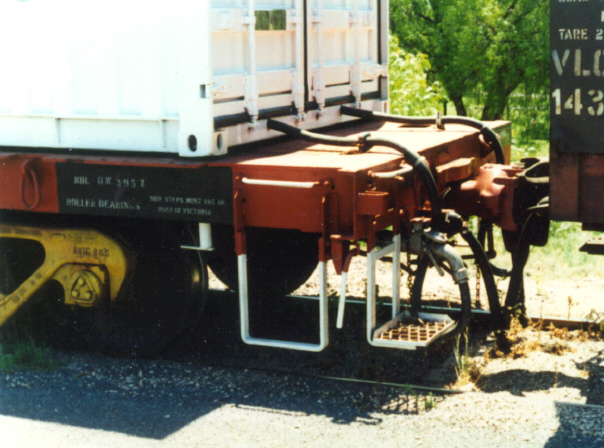
A closer view of the power supply cables leading from the Power Pack to connections at the end of the container wagon. Mildura. 15-1-1991. Photo: Bruce McLean
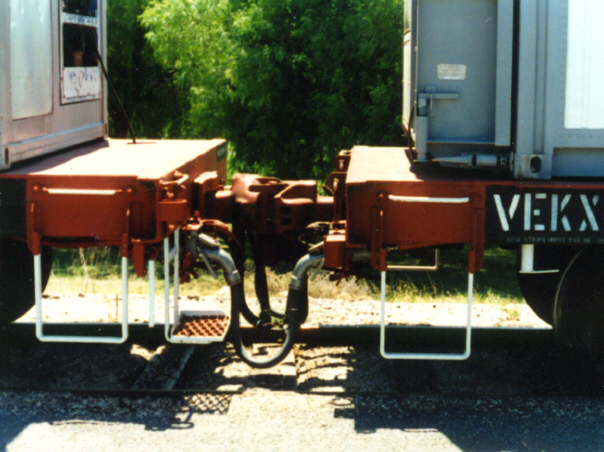
The power cable connection arrangements between each wagon. Mildura 19-1-1991. Photo: Bruce McLean
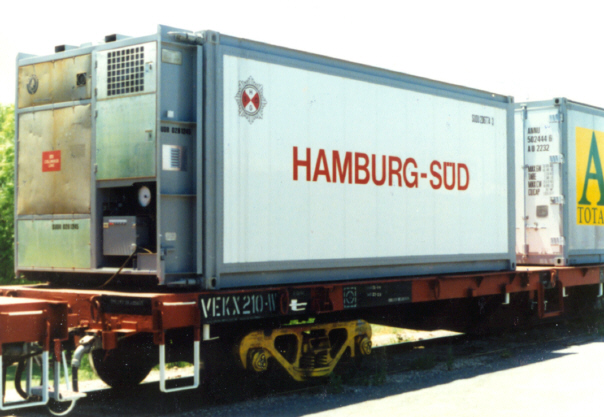
Power-refrigerated container with the power supply generated from the independent Power Pack. The advantage of this system was the ability to maintain fresh produce at a constant temperature from the point of loading to the point of unloading at its export destination. Mildura 19-1-1991. Photo: Bruce McLean
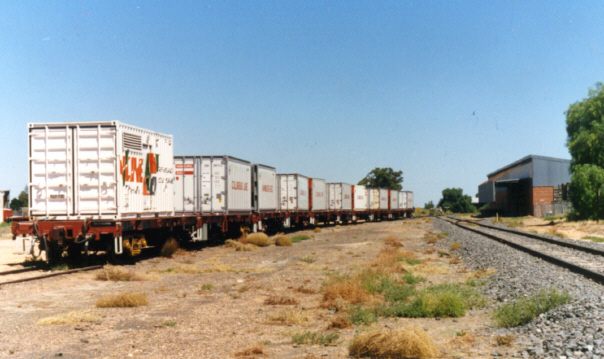
A rake of refrigerated containers powered by V/Line Power Pack PP02 at Merbein. 13-2-1991. Photo: Bruce McLean
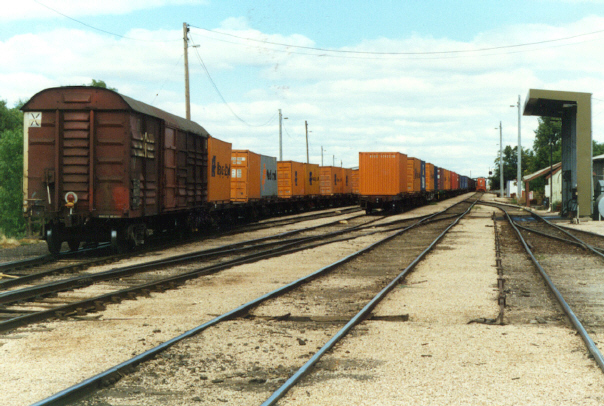
Mildura yard was at near full capacity with containers for export traffic during the 1991 dried fruit harvest. 11-3-1991. Photo: Bruce McLean

In April1991, the Mildura Freightgate ran an aggressive campaign in "Sunraysia Daily" newspaper. Source: Bruce McLean Collection
In May 1991, V/Line announced a freight service for single cartons of fruit or vegetables consigned from Mildura or Redcliffs stations across Victoria for $6.00 per carton. The service was aimed at those people in the Sunraysia area who sent fruit to friends and relatives.
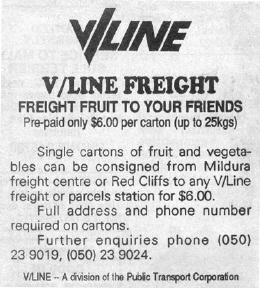
Advertisement for "Freight Fruit To Your Friends" promotion by Mildura Freightgate. May 1991. Source: Bruce McLean Collection
In July 1991 there was a significant increase in cement traffic to Mildura from Waurn Ponds, near Geelong in connection with the construction of a concrete bridge at Tibooburra, north of Broken Hill, and 57 kms. from the Queensland border. The cement was discharged at the Mildura stockyards siding into road tankers for haulage to the construction site.
Later in the year, significant quantities of cement were being forwarded by road from Mildura to Broken Hill where it was being used to seal the North Mine. Two road trains were running three return trips from Mildura each week with about 400 tonnes a day arriving from Waurn Ponds by rail.
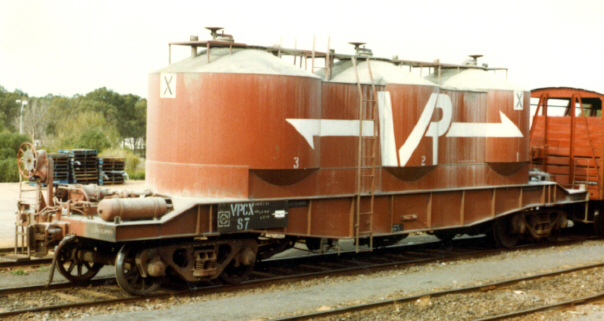
VPCX bulk cement wagon at Mildura on 24-8-1983. Photo: Bruce McLean
By mid-1991, freight services on the Ouyen to Mildura corridor consisted of 11 arrivals and 13 departures at Mildura. A description of the services follows:
Arrivals |
Notes |
9141 Melbourne Yard to Mildura goods 5.40 p.m. (Tuesday, Thursday 6.25 p.m. (Monday, Wednesday Friday) |
("Sunraysia Fresh" - formerly "Fruit Flier") Usually X Class locomotive, but when extra tonnage various locomotive class combinations including S+S, X+X, X+S. Occasionally an A Class locomotive rostered. |
9139 Corio to Mildura Block Oil 12.50 a.m. (Tuesday, Thursday) |
Usually hauled by X+T or X+H combinations. Occasionally X Class locomotive rostered solo. |
Departures |
|
9142 Mildura to Melbourne Yard goods 3.45 p.m. (Sunday, Monday, Tuesday, Wednesday, Thursday) |
("Sunraysia Fresh" - formerly "Fruit Flier") Usually X Class locomotive, but when extra tonnage various locomotive class combinations including S+S, X+X, X+S. Occasionally an A Class locomotive rostered. |
9140 Mildura to Corio Block Oil 5.25 p.m. (Monday, Wednesday) |
Usually hauled by X, H or T Class locomotive. |
NOTES: |
Passenger trains have either an N or A Class locomotive. When the grain program is operating, G Class locomotives are used exclusively. A B Class locomotive is rarely used on Mildura trains. |
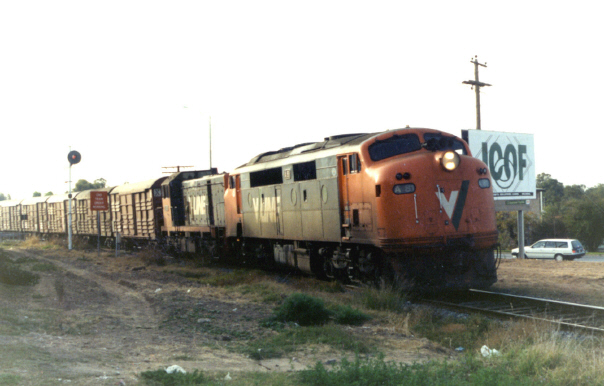
A81 and T405 pass over the Seventh Street, Mildura, level crossing as they power their load out of the Mildura station yards for the overnight run to Melbourne with the "Sunraysia Fresh" express goods service. 25-9-1991. Photo: Bruce McLean
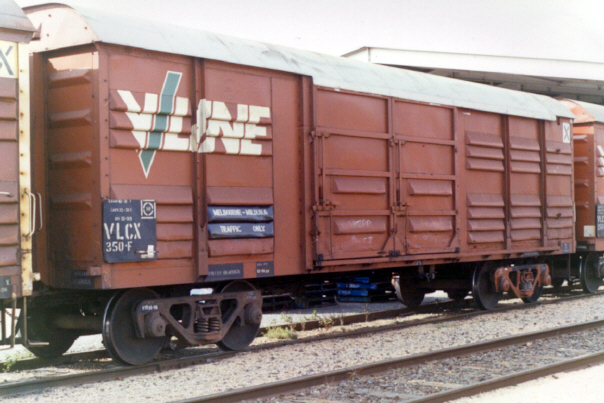
Several VLCX wagons were stencilled "Melbourne - Mildura Traffic Only" for use on the "Sunraysia Fresh" overnight express goods service. Mildura. 5-6-1991. Photo: Bruce McLean
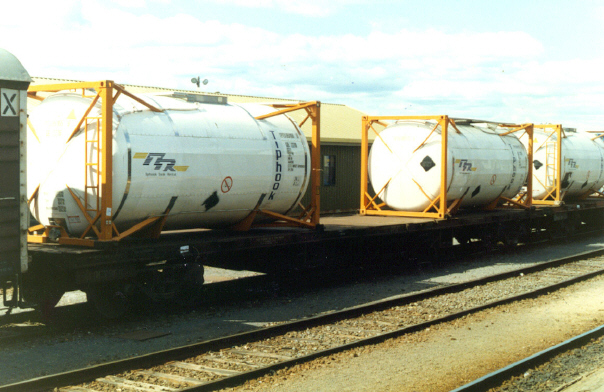
Specialised container traffic with Grants Whisky for Mildara Winery, Merbein, at Mildura on 29-8-1991. Photo: Bruce McLean
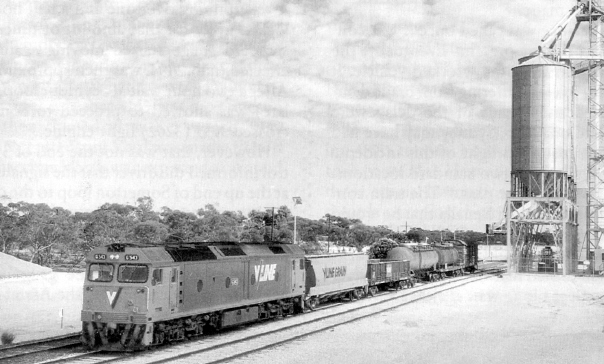
G543 departs Carwarp after attaching a grain wagon on No.9152 Up Mildura roadside goods on 3-1-1992. Photo: Peter Foote
Lindeman's Winery at Karadoc, near Redcliffs, called on V/Line for assistance with a storage problem. The solution was for the company to hire seven VLCX wagons and to place them in the Mildura carriage shed where they could be monitored for security. The wagons were there for about a week at the end of June 1992.
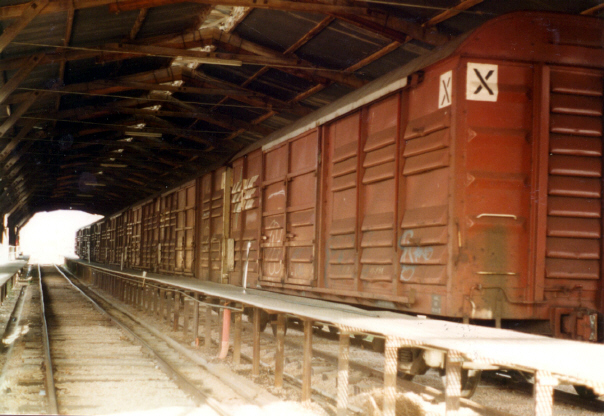
VLCX wagons loaded with Lindeman's wine products in the Mildura carriage shed. 30-6-1992. Photo: Bruce McLean
On 2-12-1992, a special train consisting of locomotive G540, two empty and one loaded container wagons, was scheduled from Maryborough to Mildura for the purpose of testing for clearance along the route for larger size container traffic. G540 was specially equipped with a video camera and monitor in the rear cabin set to observe the containers on the centre wagon. The containers featured styrene shapes fitted to their tops and any impact by an object too close to the train load would be have a minimum impact and the video camera would record the incident.
It was also proposed to route Melbourne - Adelaide superfreighters via the Mildura line to Ouyen and then across country through Pinnaroo to Tailem Bend during the conversion of the line between those centres to standard gauge. The following day, 3-12-1992, the Test Train worked from Merbein to Maryborough.
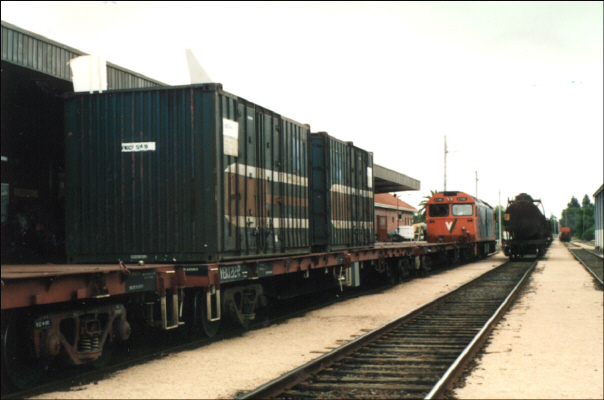
G540 and the Profile Test Train standing at Mildura station platform. Note the styrene shapes on the top of the containers for clearance testing. 2-12-1992. Photo: Bruce McLean
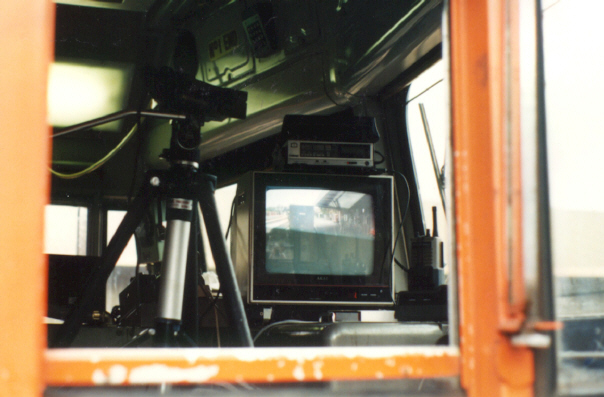
The video camera and monitor in the trailing cabin of G540 for observing profile clearance testing along the route from Maryborough to Merbein. Mildura 2-12-1992. Photo: Bruce McLean
On 10-2-1993, instructions were issued to allow containers up to and including 12.19 metres x 2.50 metres x 2.89 metres to be transported at line speed between Dunolly and Merbein but excluding the passenger tracks at Donald, Woomelang and Mildura and the goods shed tracks at Ouyen and Birchip.
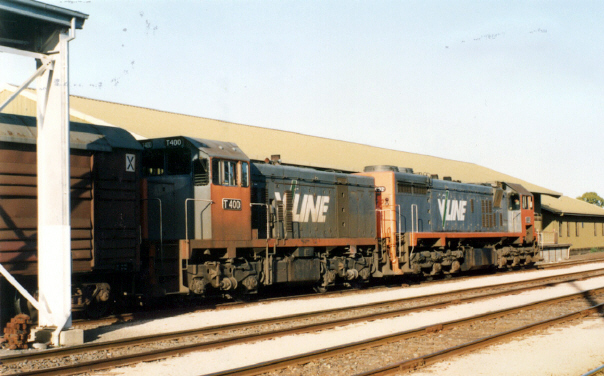
X32 and T400 team up to lead the "Sunraysia Fresh" express goods service from Mildura on 28-4-1993. Photo: Bruce McLean
A new V/Line Superfreighter rail service between Melbourne and Mildura commenced on 29-6-1993, replacing the "Sunraysia Fresh" express goods service. The new service was part of the V/Line intermodal freight concept designed to take long haul cartage of goods off State roads. Mr. M. Halley, V/Line Intermodal Marketing Manager, said that the concept behind the Superfreighter service was that it would "run like clockwork" because reliability was the prime requirement of customers. The Mildura line was the longest haul in Victoria and was suited to intermodal haulage. V/Line would be working to attract business from the South Australian Riverland and Broken Hill through the Mildura freight terminal. The existing Fast track domestic freight service to Mildura was converted to the intermodal system and curtain-sided containers were introduced, replacing conventional wagons.
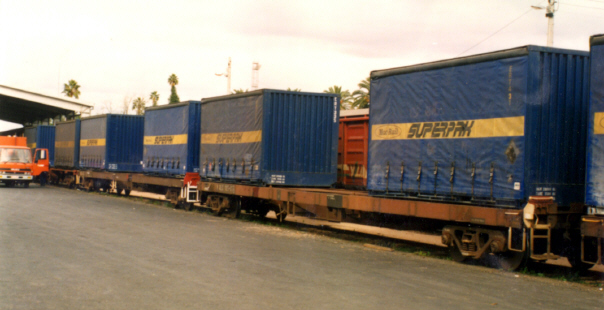
New curtain sided containers for Superfreighter traffic. The first Superfreighter ran from Melbourne to Mildura on 29-6-1993 and these wagons were photographed at Mildura the following day. Photo: Bruce McLean

Curtain sided container at Mildura on the first Superfreighter arrival on 30-6-1993. Photo: Bruce McLean
The Superfreighter was scheduled to depart Mildura at 4 p.m. for Melbourne with pick ups at Ouyen, Donald, Maryborough and Ballarat. Arrival at the Melbourne Wholesale market was scheduled for 2 a.m..
The Melbourne Yard to Mildura goods was rescheduled to arrive at Mildura at 9.25 a.m., several hours later than the original timetable that had been in place for decades. On the first day of the new schedule, G513 arrived 90 minutes late and at least three customers cancelled their use of the service.
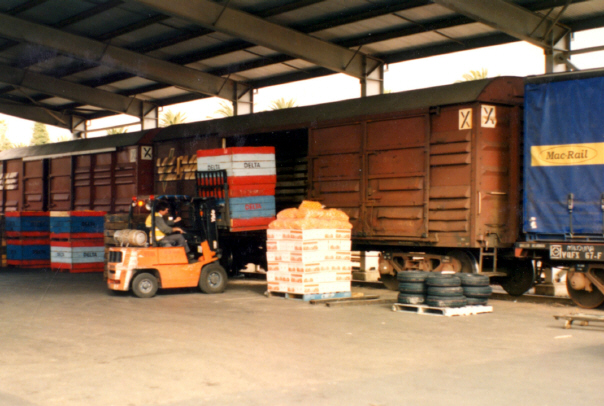
Loading Fast Track freight at Mildura Freightgate on 30-6-1993. Superfreighters commenced running to Mildura on 29-6-1993. Photo: Bruce McLean
The Power Pack refrigerated container service introduced by V/Line in 1991 was given a resurgence on 13-8-1993 with the introduction of an intermodal approach to the export of table grapes. Merbein was selected as the hub for Sunraysia intermodal deliveries making an uninterrupted cold chain with a combination of road transport, trains and ships strictly scheduled to ensure that fruit was maintained at a constant temperature.
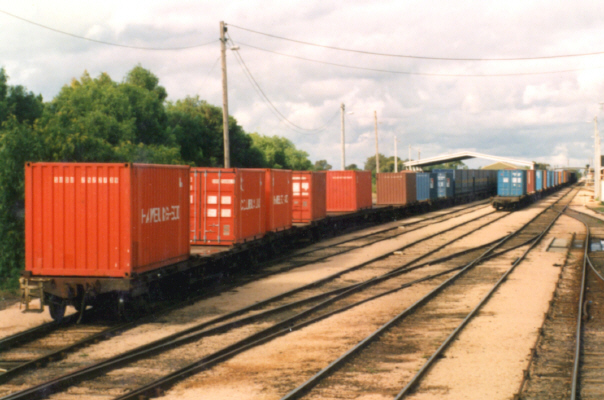
Container wagons in the goods yard at Mildura. 10-7-1993. Photo: Bruce McLean
Following the last passenger train from Mildura on 12-9-1993, V/Line Freight were quick to reassure freight customers that the line was not closing and that they would be seeking new markets. There was a reassurance that wool would continue to be freighted out of Mildura and Ouyen with a train taking wool every Monday and Wednesday to Geelong or Melbourne.
Cement was big traffic for V/Line Freight with 8 to 10 wagons arriving at Mildura every second day for Blue Circle Cement. There were also about 10 wagons kept in reserve at Mildura railway yards. In August 1993, 360,000 tonnes of cement was sent to Broken Hill where cement is used to "back fill" redundant mine shafts. The cement was forwarded from the Blue Circle Cement factory at Geelong, to Mildura. A fleet of road transports were used to make the connection between Mildura and Broken Hill.
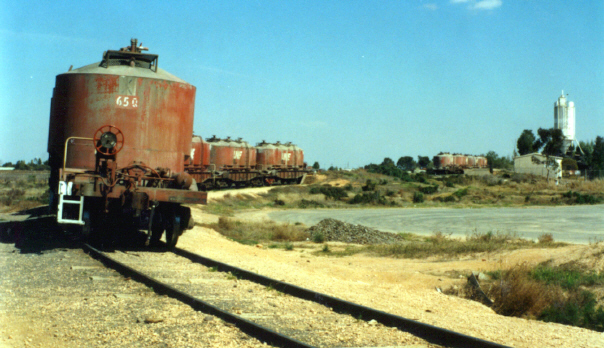
JCPX bulk cement hopper wagons at Mildura Cement Siding for Blue Circle Cement. 29-8-1993. Photo: Bruce McLean
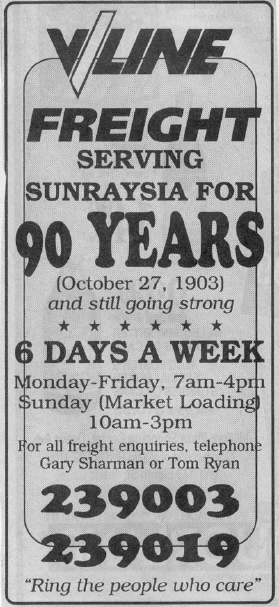
Advertisement placed by Mildura Freightgate to reinforce the continuing freight service to Mildura following cancellation of "The Vinelander". 10-11-1993. Source: Bruce McLean Collection
The Minister for Public Transport, Mr. A. Brown, announced in September 1993, that the Dimboola to Yaapeet, Murtoa to Hopetoun and Ararat to Portland lines would be converted from broad to standard gauge in association with the conversion of the Melbourne to Adelaide to standard gauge. Grain from the Hopetoun and Yaapeet lines would be railed direct to Portland for export. The work was scheduled for completion by April 1995.
At the same time, the Managing Director of V/Line Freight, Mr. M. Van Onselen, defined the new structure for V/Line Freight around four key portfolios: Grain, Industrial Products, Intermodal and Fast Track. Mr. Van Onselen also declared that it was the task of V/Line Freight "to run a business rather than just a railway" and build on V/Line's increasing competitiveness and as a commercially sustainable business.
Following the demise of "The Vinelander" passenger service to Mildura on 12-9-1993, V/Line Freight secured some on-going business from Mildura motor vehicle traders for Motorail services. The service was also expanded with a flat bed container wagon being made available for the carriage of four-wheel drive and commercial vehicles that would not fit into the Motorail wagons. The Melbourne destination was the Dynon Container Terminal.
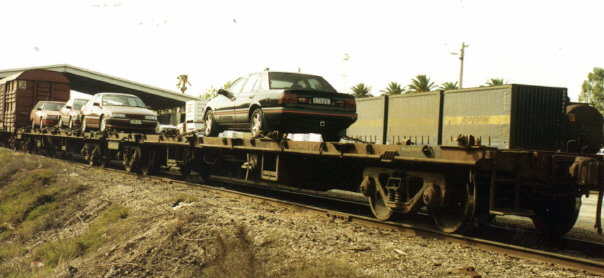
Motor vehicles on a container wagon for transport between Melbourne and Mildura by V/.Line Freight. 23-12-1994. Photo: Bruce McLean
The traffic did not develop to any great extent and was discontinued after about a year, the loading ramps remaining at Mildura in the event of any revival of this traffic.
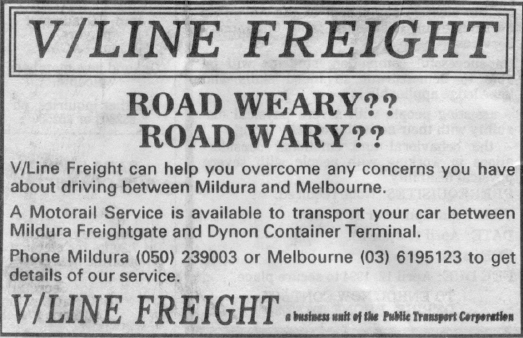
V/Line Freight advertisement promoting Motorail service on goods trains. 26-3-1994. Source: Bruce McLean Collection
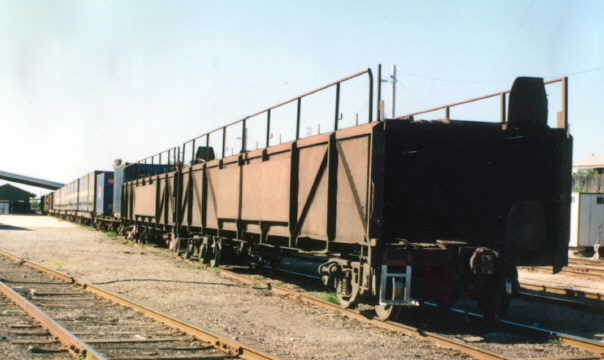
Motorail wagons VLPY10 and VLPY9 on the rear of the up Superfreighter at Mildura on 12-3-1994. Photo: Bruce McLean
Cement, fuel, grain, containers and general freight became the mainstay of traffic at Mildura, Merbein and Yelta with gypsum from Cowangie and grain from silos along the Pinnaroo line adding to the corridor traffic at Ouyen.
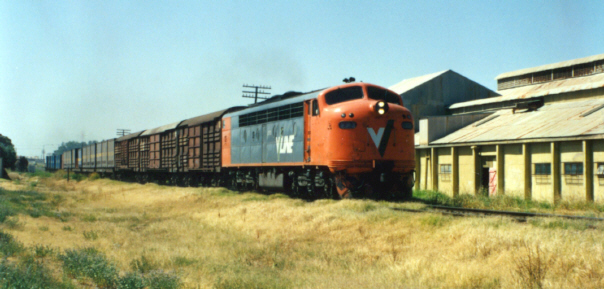
A rare occasion with S313 running the up Mildura Superfreighter as it passes the site of the former Mildura Co-operative Fruit Co. siding on 27-1-1994. S Class were usually rostered to Mildura with a second locomotive because of its single ended driving characteristic. Photo: Bruce McLean
The government announced in March 1994 that it proposed to deregulate V/Line in a phased form by December 1995. Under the existing regulations, the bulk of the State's grain and a significant amount of cement, briquettes and petroleum must be transported by rail. The government deregulation plans offered the prospect of reduced transport costs through greater competition, according to the Minister for Public Transport, Mr. A. Brown. It was proposed to deregulate cement and briquettes by December 1994, petroleum by June 1995 and grain by December 1995.
Mr. G. Martin from the Mildura Shell distributor, Martin Petroleum, said on 4-3-1994 that it was a misnomer that the rail freight for petrol was dearer than by road. Mr. Martin claimed that the fuel delivery costs to Sunraysia had been held down by the competitive pricing of V/Line and it was better to focus on the price it could be bought from wholesalers.
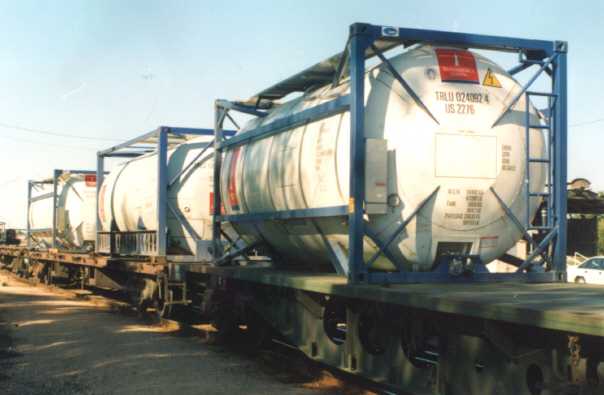
Special design container-shape tanks for imported whisky from the United Kingdom to Mildara Winery at Merbein. Mildura 3-7-1994. Photo: Bruce McLean
Freight innovations continued to flow out of the V/Line intermodal system which had been set up to service the Sunraysia region. In June 1994 one successful innovation was the containerisation of briquettes supplied to Mildura Base Hospital. Briquettes were loaded into containers at Morwell and then railed through to Merbein from where intermodal contractors, Wakefield's, delivered to the Mildura Base Hospital briquette bunkers. Before the new system was put into place, rail wagons were loaded at Morwell and unloaded into an intermediate storage at Redcliffs. Tip trucks then carted the fuel to the hospital.
Another development was a new siding onto land owned by Wakefield's in Merbein to refine further the intermodal "Hub" concept. Mr. M. Halley, Intermodal Marketing Manager of V/Line Freight described the development as a proper freight terminal with container storage.
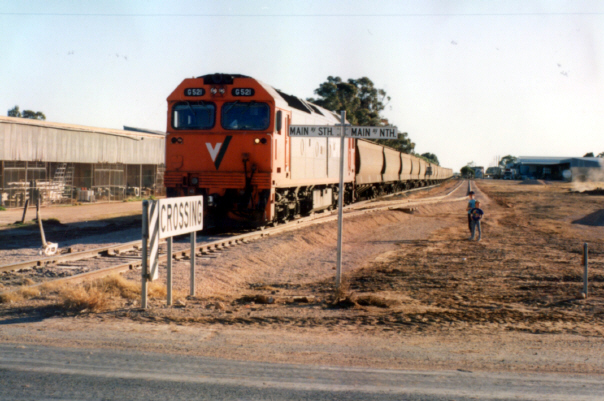
The new loop siding constructed at Merbein for intermodal traffic was located on the down side of the Calder Highway level crossing on Wakefield's Transport site. G521 on an up grain train from Yelta passes the newly completed loop on 6-7-1994. Photo: Bruce McLean
The changing nature of V/Line Freight to a more commercial-based operation was evident in the results of productivity improvements released for the 1993/1994 year:
* Revenue was up by 20% to $182 million;
* Tonnes carried up by 24% to $12 million;
* The locomotive fleet was reduced by a further 7 units to 166;
* The wagon fleet was reduced by 90 vehicles to 3,390;
* V/Line Freight staff was reduced by 25% to 1,370.
Conversion of the Murtoa to Hopetoun and Dimboola to Yaapeet lines to standard gauge commenced in March 1995 and was completed by 18-5-1995. The government also announced that conversion of the Ararat to Maryborough line would commence and a third rail for standard gauge trains would be added to the Maryborough to Dunolly section. With conversion of the Melbourne to Adelaide line completed, Victoria now had a separate grain division exclusively on standard gauge.
During the conversion of the Melbourne to Adelaide line to standard gauge, broad gauge freight trains between the two cities were diverted to run on the Mildura line as far as Ouyen, and then run across the connecting line between Ouyen and Tailem Bend, via Pinnaroo, providing some entertaining train watching for railway enthusiasts and locals alike.
Commencing on 22-4-1995, National Rail freight trains were scheduled through Ouyen and Pinnaroo whilst the Adelaide line conversion was in action. V/Line Freight positioned two T Class locomotives at Ouyen for the task.
Approval was extended on 24-1-1995 for 2.896 metre high x 2.502 metre wide containers to be transported at line speed between Ouyen and the South Australian border.

844+859+847+706 departs Ouyen on 9163 Superfreighter to Adelaide. 25-4-1995. Photo: Gavin McLaughlan
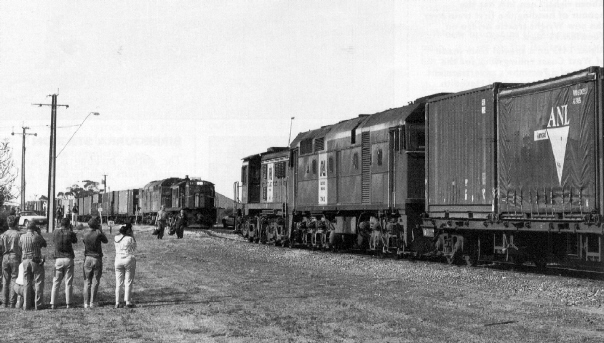
847+706 arrive at Pinnaroo on 9163 Superfreighter to Adelaide as the Victorian-based National Rail Corporation crew walk towards 843+704 on 9168 on 22-4-1995. Photo: Gavin McLaughlan
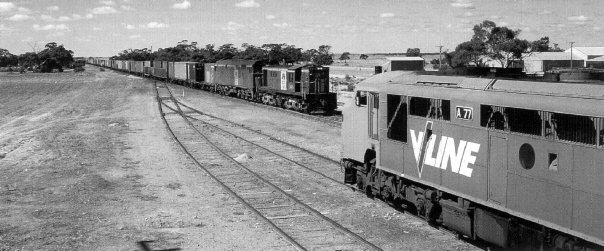
A77 on 9138 goods to Ouyen crosses 847+706 on an Adelaide-bound Superfreighter at Cowangie on 22-4-1995. Photo: Ian Green
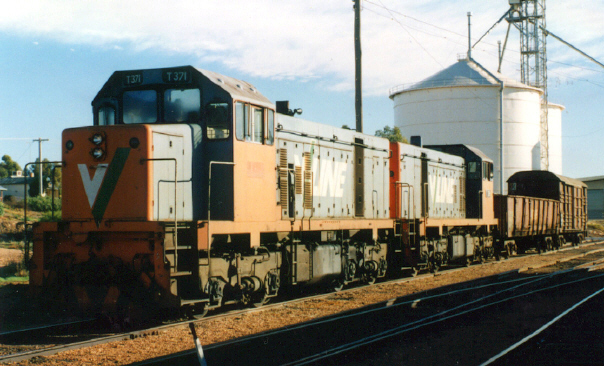
T371 and T388 were sent to Ouyen during the period of interstate freight train running whilst the Melbourne to Adelaide line was being converted to standard gauge. 12-5-1995. Photo: Bruce McLean
Trains commenced operating on the new and converted standard gauge lines from Melbourne to Wolseley (and Adelaide), Maroona to Portland and Murtoa to Hopetoun on 23-5-1995, ending Ouyen's month of high volume interstate traffic.
(From Australian Railway Historical Society Bulletin, July 1995)
The first Adelaide to Melbourne freight train diverted via Pinnaroo left Tailem Bend on 18-4-1995 headed by 703+847+706. The diversionary services via Pinnaroo and Ouyen in conjunction with the Melbourne to Adelaide standardisation project ran without any major problems. Despite some atrocious timekeeping in the initial stages, things steadily improved over the fortnight that the diversions ran.
Initially trains were operated by 700+830+700 combination working through to Ouyen but the second 700 was quickly deemed unnecessary and most trains were hauled by one 700 and one 830, with either unit leading. A few lighter trains were operated throughout by two 830's. One loco balancing led to led to the interesting combination of 830+830+830+700 departing Ouyen. On at least one occasion, the local V/Line grain and gypsum services were combined with the Pinnaroo diversion services.
The last two eastbound freights, due to run on 28-4-1995, were cancelled and the honour of the last eastbound broad gauge movement through to Tailem Bend was handed to a four-car Adelaide suburban "Red Hen" railcar set, purchased by the South Gippsland Tourist Railway. It left Adelaide at 5 a.m. on 28-4-1995, travelling via Pinnaroo and Ouyen to reach its destination.
The last westbound movement arrived in Adelaide in the very early hours of 29-4-1995.
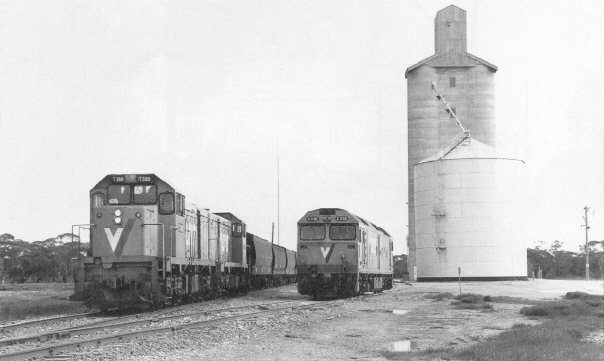
T388 and T374 arrive at Carina with a grain train from Tailem Bend. G532 in the siding, will be added to the consist for the journey to Ouyen. 29-7-1995. Photo: Gavin McLaughlan
In mid-November 1995, V/Line and Wakefield's Transport, through the intermodal hub at Merbein, began a program of transporting crushed blue metal from Boral's Dunnstown Quarry near Ballarat to Merbein using a specialised road/rail container system. The half-height containers each held 21 tonnes and were lifted off the train on arrival at Merbein and stacked for later delivery or placed on a "Skel" tri-axle semi-trailer tipper frame and take by road to a Mildura Rural City Council stockpile.
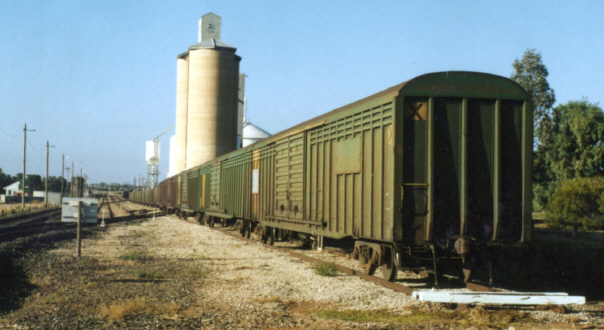
Specialised Container Transport (SCT) purchased a number of former Australian National RBFX box vans for interstate traffic to Perth. The wagons were transferred on broad gauge from Adelaide to Melbourne via Tailem Bend, Pinnaroo and Ouyen following conversion of the Adelaide line to standard gauge. Twenty-two of the vans were noted in transit at Ouyen on 30-3-1996. Photo: Bruce McLean
In June 1996, V/Line Freight introduced a new type of side-loading container specially manufactured for Fast Track services to Freight Gates. The containers were manufactured in Tasmania by Doric Engineering. The first appearance of the containers at Mildura was on 7-6-1996.
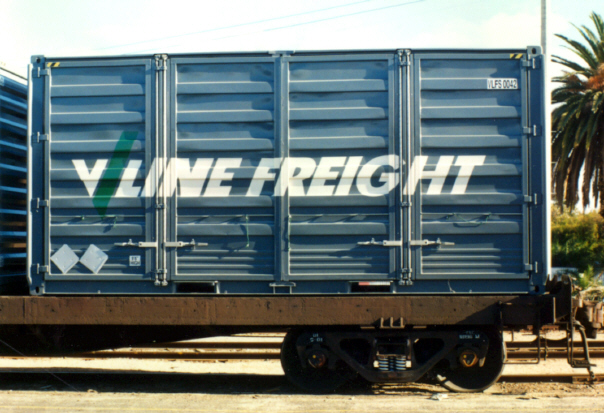
New side-loading container for V/Line Fast Track freight to regional Freightgates. Mildura 7-6-1996. Photo: Bruce McLean
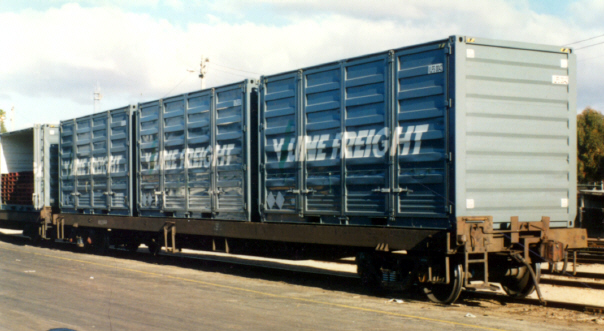
Three of the new containers were accommodated per flat wagon. Mildura. 7-6-1996. Photo: Bruce McLean
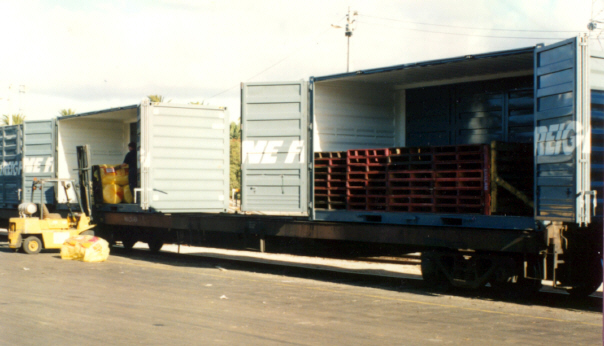
The new Freightgate containers showing the side-opening arrangement for ease of loading and unloading. Mildura. 7-6-1996. Photo: Bruce McLean
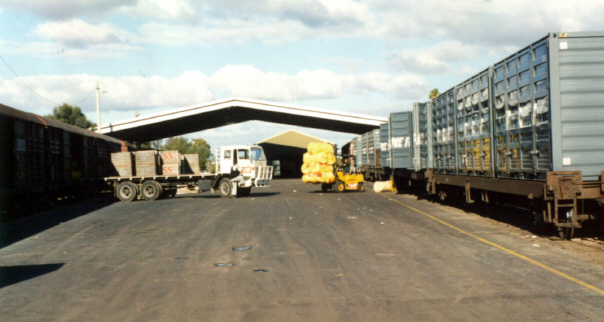
The scene at the Mildura Freightgate on 7-6-1996. Photo: Bruce McLean
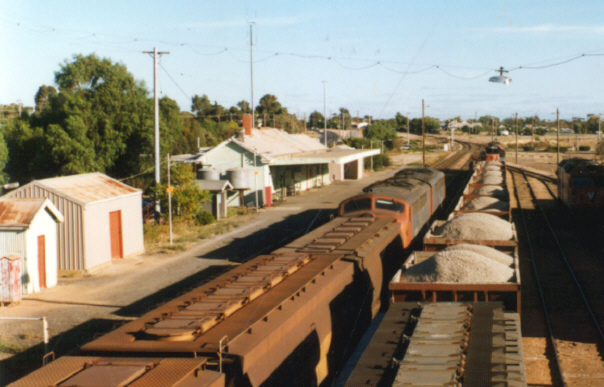
Hallmarks of the rail traffic at Ouyen - grain and gypsum. On the left S301/S306 are at the head of a grain train for the Murrayville line and to the right, G532/X42 stand at the head of an up train with gypsum and grain. 5 p.m. 4-4-1997. Photo: Bruce McLean
Board directors were appointed to a new rail freight body called V/Line Freight Corporation in January 1997. V/Line Freight Corporation, set up as an independent body from the Public Transport Corporation, commenced on 1-7-1997 and was the entity that would eventually be sold off in the privatisation process.
The "Fruit Flier" fast goods between Mildura and Melbourne passed into history in September 1997. 9142 Up freight, still known by locals as "The Fruity" was cancelled in favour of amalgamation with 9140 Up freight. Down freight services were similarly altered with the cancellation of 9139 Down goods. These changes took effect from 7-9-1997, however freight obligations kept the "Fruit Flier" running until 28-9-1997, leaving Mildura with only one van and using T or P Class locomotives. Locomotive P19 ran the last "Fruit Flier".
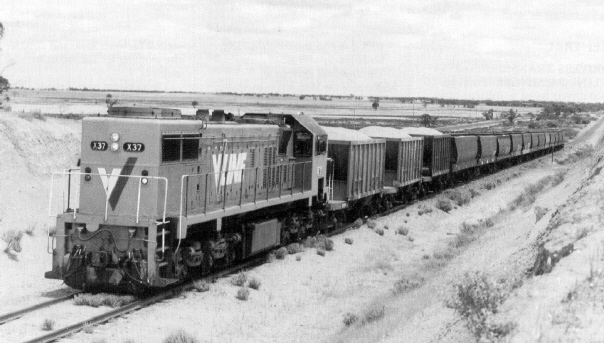
X37 powers 9138 loaded gypsum train from Cowangie up the grade approaching the Mallee Highway level crossing west of Ouyen. 11-11-1997. Photo: Simon King
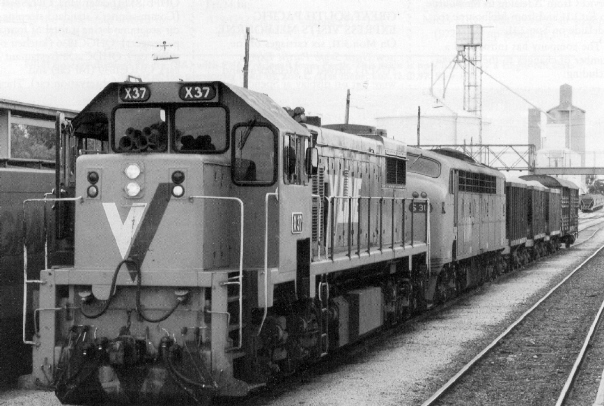
After arriving at Ouyen, 9138 was remarshalled with X37 and S301 leading a consist with additional loading. The train is pictured here waiting departure for North Geelong yard. 11-11-1997. Photo: Simon King
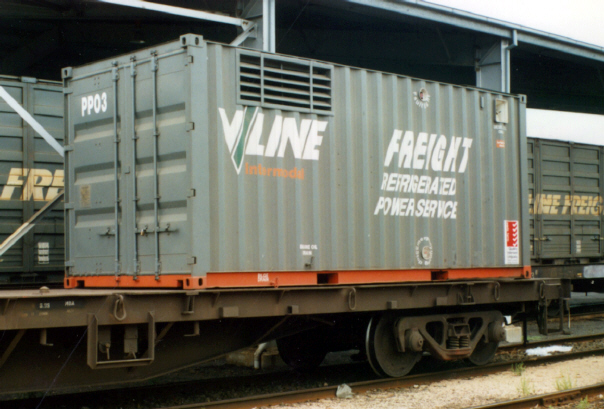
V/Line Freight Intermodal refrigerated power pack in V/Line Freight color scheme. Mildura 10-1-1998. Photo: Bruce McLean
The Victorian Government announced on 22-2-1999 that Freight Victoria had been selected as the successful purchaser of V/Line Freight Corporation under a 15 years renewable lease to operate and maintain Victoria's country rail network from 1-5-1999.
The carriage of freight on Victoria's railways was now under the control of an American based company.
| << Back | Home | Site Map | Copyright © 2003 Bruce McLean, All Rights Reserved |